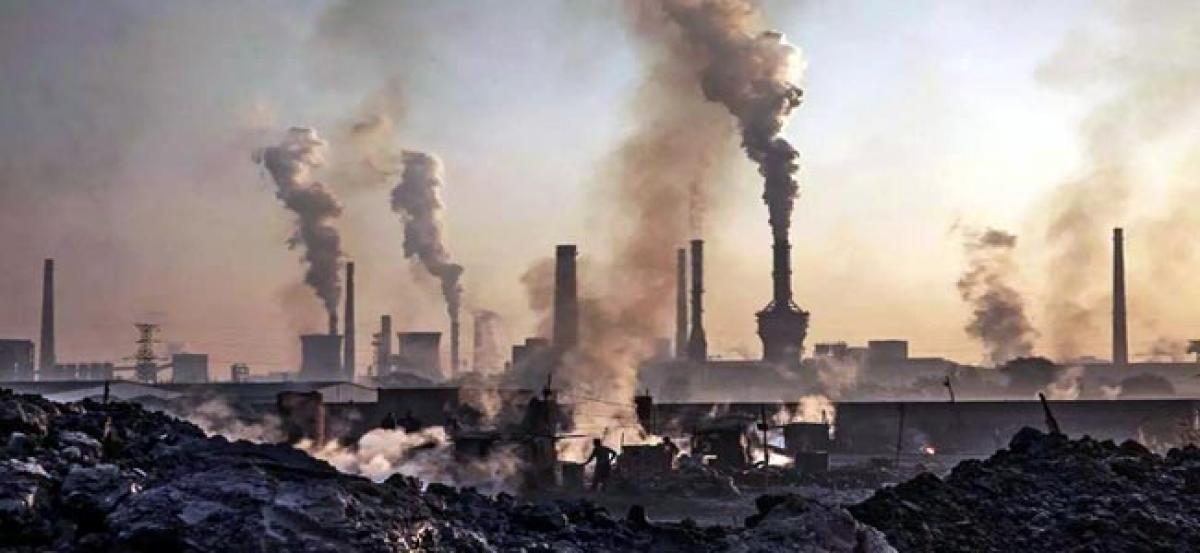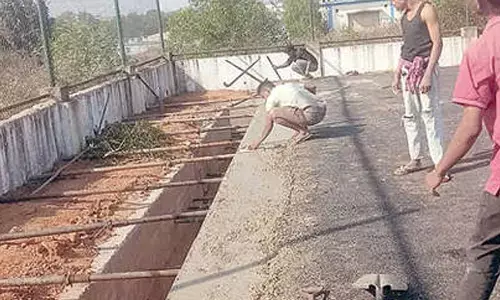Staying cool – Eliminating HCFCs

Hydrochlorofluorocarbons (HCFCs) have always been considered as an interim solution to Chlorofluorocarbons (CFC) Phase-out, because of their
Hydrochlorofluorocarbons (HCFCs) have always been considered as an interim solution to Chlorofluorocarbons (CFC) Phase-out, because of their lower Ozone Depleting Potential (ODP) which is between 5-10per cent when compared to CFCs. While the Global Warming Potential (GWP) of HCFCs is high (600-2,200 CO2-equivalent), it is much lower than that of CFCs (6,000-10,600 CO2-equivalent).
The majority of HCFCs have a high GWP. Their phase-out through the introduction of lower GWP alternatives will therefore contribute significantly to climate change mitigation. Depending on the alternative selected, this contribution can be very significant or can be so deleterious and of such magnitude as to nullify the efforts a country is undertaking via other voluntary actions, such as efficient lighting or appliance replacement programmes to achieve energy savings.
What are HCFCs
Hydrochlorofluorocarbons (HCFCs) are a large group of compounds, whose structure is very close to that of Chlorofluorocarbons (CFCs), but including one or more hydrogen atoms. Under normal conditions, HCFCs are gases or liquids which evaporate easily. They are generally fairly stable and unreactive. HCFCs do not usually dissolve in water, but do dissolve in organic (carbon-containing) solvents. HCFCs are chemically similar to Hydrobromofluorocarbons (HBFCs), Chlorofluorocarbons (CFCs) and Halons and therefore display some similar properties, though they are much less stable and persistent. HCFCs are also part of a group of chemicals known as the volatile organic compounds (VOCs).
How might it affect the environment?
HCFCs are unlikely to have any impact on the environment in the immediate vicinity of their release. As VOCs, they may be slightly involved in reactions to produce ozone, which can cause damage to plants and materials on a local scale. At a global level however, releases of HCFCs have serious environmental consequences. Although not as stable and therefore not so persistent in the atmosphere as CFCs, HBFCs or Halons, they can still end up in the higher atmopshere (stratosphere) where they can destroy the ozone layer, thus reducing the protection it offers the earth from the sun’s harmful UV rays. HCFCs also contribute to Global Warming (through “the Greenhouse Effect”). Although the amounts emitted are relatively small, they have a powerful warming effect (a very high “Global Warming Potential”).
In 2007, the Parties to the Montreal Protocol agreed to accelerate the phase-out of HCFCs (initially targeted for 2040) largely because of the substantive climate benefits this would bring about. Parties operating under the Montreal Protocol’s Article 5(1) (mostly developing countries) may receive financial assistance from the Multilateral Fund for the implementation of the Montreal Protocol (MLF) to formulate their overarching strategy and prepare HCFC Phase-out Management Plans (HPMPs). The control steps under the adjusted Montreal Protocol for these parties are: i) “freeze” of HCFC production and consumption by 2013 (the baseline being the average of 2009 and 2010); ii) reduction of 10per cent by 1 January 2015; iii) 35per cent reduction by 2020; iv) 67.5per cent reduction in 2025; v) 97.5per cent reduction by 2030; and vi) 100per cent phase-out by 2040.
Currently, UNDP is assisting developing countries and countries with economies in transition to comply with the HCFC consumption freeze and the 10per cent reduction targets. As the lead agency in 30 developing countries UNDP is supporting the preparation of their HCFC Phase-Out Management Plans (HPMPs). Combined, these countries represent 77per cent of the global consumption of HCFCs.
UNDP also supports countries in the preparation of investment projects for the conversion of manufacturing processes to non-HCFC alternatives in the foam, refrigeration and air-conditioning, solvents and other sectors.
HCFC elimination in those sectors can bring energy efficiency gains and significant climate benefits through proper selection of alternatives.
In short, UNDP’s country assistance contains the following main elements
- Institutional Capacity Development –Analyzing existing administrative practices and institutional structures controlling ODS, and specifically HCFCs, by assessing gaps, deficiencies and needs; and recommending changes and identifying resources available/necessary to meet Montreal Protocol obligations.
- Assessment and Demonstration of HCFC Alternative Technologies - Providing technical support and information with respect to alternative technologies and substances, taking into consideration, inter alia, ozone, climate benefits and energy efficiency; facilitating engagement of industrial and commercial enterprises in discussions related to alternative technology developments/assessments; assessing new low carbon technologies for use in developing countries; and promoting South-South cooperation.
- Technical Assistance and Technology Transfer – Support to countries in undertaking (sub)sector-level HCFC production and consumption surveys, technology needs assessments and situation analyses on HCFC import, export/re-export and distribution channels; forecasting HCFC production and consumption patterns, undertaking prioritization with respect to HCFC phase-out and developing comprehensive strategies and action plans for HCFC phase-out management looking into low-carbon national and sectoral strategies.
- Maximizing Climate Benefits in the Refrigeration and Air Conditioning – Careful analysis and calculation of net impact to climate of alternative technologies and supporting countries to combine and sequence the funding to implement the transformation to technologies which will maximize climate benefits of planned HPMP.
- Policy and Regulatory Interventions – Analyzing current compliance status and preparing consumption-based future compliance projections; undertaking analysis of legal and regulatory frameworks governing ODS and specifically HCFCs, such as licensing and import/export controls; identifying gaps and deficiencies in existing regulatory frameworks and recommending changes to maintain consistency with Montreal Protocol obligations.
- Increased Access to Funding – Supporting countries in securing financial support from the MLF to meet compliance with the Montreal Protocol, and assisting in identifying and mobilizing additional financial resources to address climate co-benefits from the GEF, carbon markets, bilateral donors, and other sources.
What countries can do to maximize climate benefits of HCFC phase-out?
Agreements adopted at the United Nations Climate Change Conference in Cancun, Mexico (December 2010) encourage developing countries to formulate low-carbon development strategies or plans in the context of sustainable development. It is important that countries take into account the HCFC phase-out work when developing their low-carbon strategies and plans. This will allow countries not only control potent greenhouse gases but also utilize the HCFC phase-out as a step towards transformation to green economy.
As the HCFC phase-out will lead to the need to use alternative substances, the real impact on climate will be subject to the success or failure of the selection of alternatives and the pace of their introduction in the country. In addition, a successful strategy to promote the introduction of climate-friendly alternatives as well as control of high GWP technology introduction in the country is of essence. . For example, HCFC-141b, which is a substance used commonly in foam products, has a GWP of 713 (IPCC SROC 2005). The enterprise could select to replace HCFC-141b by different available alternatives which have GWPs that can vary from over 1,000 down to less than 20. Thus, if alternative substances with higher GWP are introduced and no disincentives are put in place to avoid their use in the country, there is a large risk of having a negligible benefit on climate and/or an increased level of CO2-eq emissions.
Consequently, the net effect in climate change mitigation achieved by the HCFC phase-out will largely depend on the alternative substances that are phased in and on the country’s ability to pass and enforce regulatory measures. In addition, control on imports of equipment containing HCFCs and high GWP alternatives require monitoring. Economic disincentives also need to be put in place to reduce demand for such imports.
In particular, in the refrigeration and air conditioning servicing sectors, future consumption of HCFCs or alternatives will be subject to the refrigerant contained in the equipment being imported today and in the next five years. If a country does not carefully control the type of equipment being introduced into the market, it could inadvertently increase the future demand of high GWP substances to maintain this equipment in the future. This is particularly relevant considering that many of these appliances are imported.
In order to protect the ozone layer as well as mitigate climate change, important actions by countries are needed
- Ensure proper support to the implementation of the HPMP, in particular in the regulatory aspects, in order to guarantee that timely action is taken to achieve compliance with the Montreal Protocol.
- Consider net climate impact both due to direct and indirect emission reductions using industry-standards tools such as Life-Cycle Climate Performance (LCCP). LCCP takes into account both direct and indirect emissions of CO2 throughout the life cycle - from "cradle to grave" - originating in all components and the chemical constituents of the refrigerating plant.
- Consider economic/fiscal instruments (tax to high GWP alternatives, duties, etc.) to ensure the reduction of future demand of high GWP substances to serve equipment. Some examples of effective regulatory measures established by different countries during the CFC phase out era are available.
- Consider the possibility to account the impact in reduction of CO2-eq emissions of phasing out HCFCs in the low-carbon development strategies and plans and associated mitigation actions.
- Broaden the partnership with donor community for mobilization of resources to maximize climate co-benefits of HCFC phase-out.
India’s Strategy
India has launched the second phase of the programme to eliminate the use of hydrochlorofluorocarbons (HCFC) as part of its commitment under the Montreal Protocol, which requires the complete removal of chemicals that result in ozone depletion and aid global warming. India has already successfully implemented HPMP stage-I.
The Montreal Protocol seeks to cut the production and consumption of ozone depleting substances in order to protect the earth’s fragile ozone layer. It also aims at phase out HCFCs by 2030.
Indian HCFC phase- out plan 2
- Under HPMP-II, India has secured $44.1 million for the implementation of the Montreal Protocol for phasing out 8,190 metric tonnes or 769.49 ODP (Ozone Depleting Potential) tonne of HCFC consumption between 2017 to 2023, in order to meet the compliance targets under Montreal Protocol for 2020.
- The phase out of HCFCs in the HPMP stage-II will be addressed through several technology conversions at a number of large, medium, small and micro enterprises in the polyurethane foam sector, a few large enterprises in the air conditioning manufacturing sector and activities in the refrigeration and air conditioning servicing sector. India is committed to ensuring the smooth transition of these enterprises to new technologies and values the interest of SMEs most.
- In the process, targeted technical assistance and awareness programmes will be implemented focused on SMEs during the HPMP stage-II to ensure timely and sustainable phase out of HCFCs.
- Under HPMP-II, more than 400 enterprises, including over 300 micro, small and medium enterprises (MSMEs) in the foam manufacturing sector and six large air-conditioning manufacturing enterprises will be supported for conversion from HCFCs to non-HCFC technologies.
- The plan also provides for promotion of energy efficiency, development building codes integrating HCFC phase out issues, cold chain development with non-HCFC alternatives and development of standards for new non-ODS.
- It also specifically focuses on the MSME sector in foam manufacturing. Adequate attention has also been given to synergize the refrigeration and servicing (RAC) sector trainings under HPMP II, with the Skill India Mission, in order to multiply the impact of skilling and training. According to estimates, nearly, 16,000 service technicians will be trained under HPMP-II.
What else needs to be done?
- The data for refrigerant consumption during 2015 compiled by the European Union show that in the developing world, split air-conditioning units, car ACs and commercial refrigeration record the highest use of these chemicals. It is imperative the Central government ensures that its efforts to upgrade industries using the $44.1 million in funding available under the Protocol are scaled up to meet the need fully.
- Modernising the technology used by 400 industrial units, many of them small and medium enterprises, by 2023 has to be complemented by policy changes that encourage adoption by consumers.
- Systemic change requires the active participation of State governments, which can enact and enforce new building codes and purchase regulations that are envisaged in the current phase.
- Newer refrigerants with lower global warming potential are available to industry, and there are some early adopters, while research on chemicals with greater energy reduction and very low contribution to global warming has to continue.
- Credentialed training of service technicians in the newer technologies is welcome as it will bring about change of refrigerants used in the repair and replacement market and create additional employment.
- It is important to make consumers aware of green options among products in terms of the underlying technologies, and incentivise adoption through tax structures.
- The Environment Ministry’s proposal to prescribe energy-efficient temperature limits for air-conditioning units in public facilities is promising. A lot of energy is wasted because of poor infrastructure and lack of understanding of efficiency metrics.
- The Centre should also conduct audit of public buildings to determine whether they are suitably designed, as climate control relies as much on passive influences such as insulation, green roofing and the nature of materials used in construction.
Way ahead CFCs and HCFCs have contributed to the quality of modern life, particularly as valuable components in refrigeration and computer technology. However, their impact on the atmosphere has prompted several countries to agree to stop producing them.
- At present, HCFCs are used in various sectors like refrigeration and air conditioning (RAC) and foam manufacturing. These sectors are directly related to urban development, agriculture through cold chain, and industrial development.
- Research results suggest that there is a need to develop acceptable alternatives to HCFCs. Two possible alternatives to HCFCs are already being used successfully. Refrigerators that use propane gas, ammonia, or water as coolants are being tested in research laboratories, and use up to 10% less energy than typical models using CFCs as a coolant.
- Telephone companies are experimenting with crushed orange peels and other materials to clean computer circuit boards, as substitutes for another important use of CFCs and HCFCs. certain microorganisms are also being tested that degrade HCFCs and HFCs, which could help in controlling emissions of these compounds during manufacturing processes involving their use.
Conclusion
The continued success of the Montreal Protocol in its goal to eliminate HCFCs by 2030 will depend on reducing the acquisition costs of cleaner technologies. The greater affordability of solar photovoltaic power and its rapid adoption at various scales is a clear pointer.
More people will have access to air-conditioning and refrigeration in coming years, and the focus of government policy must be to make them energy-efficient and eco-friendly.
Gudipati Rajendera Kumar















